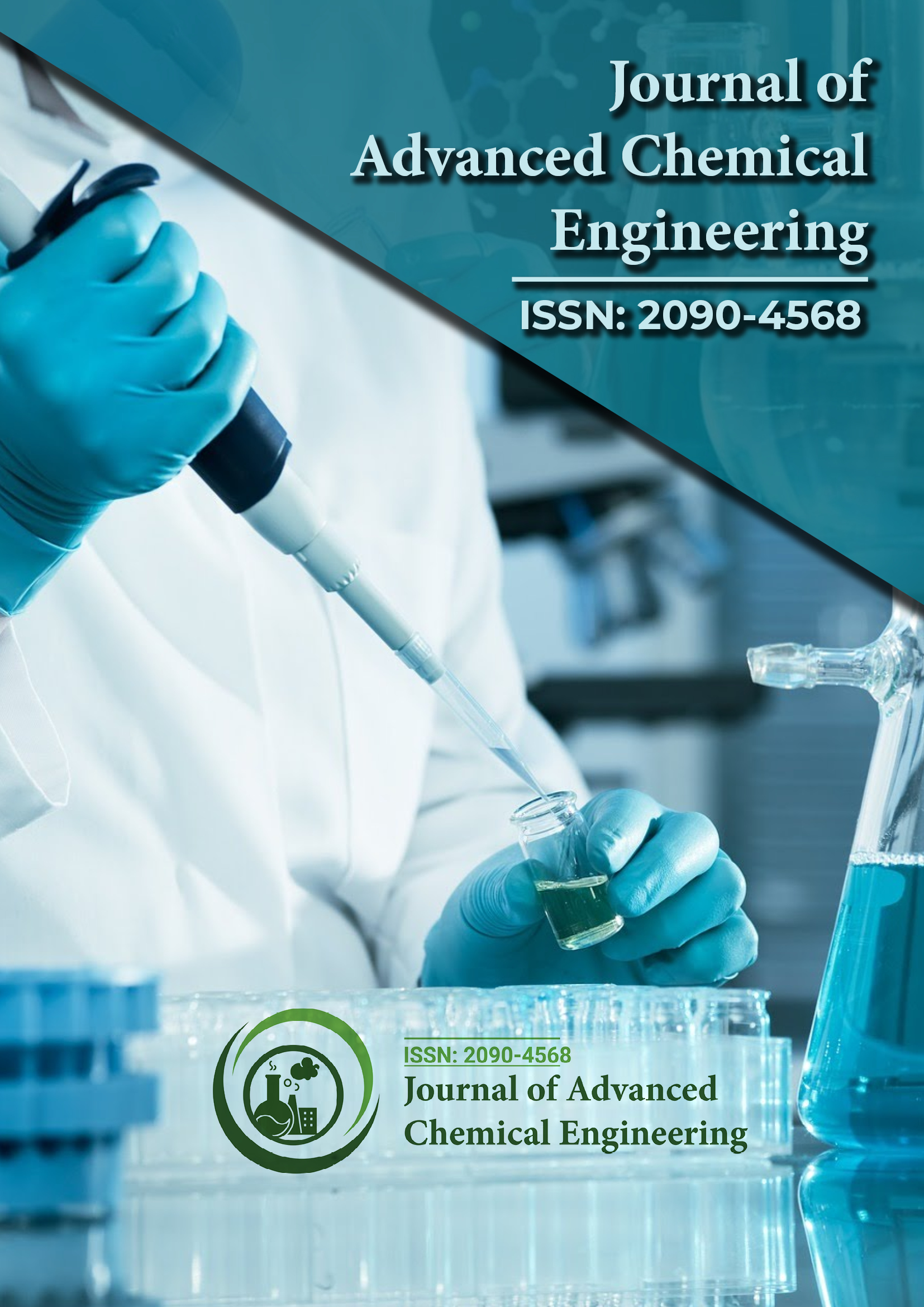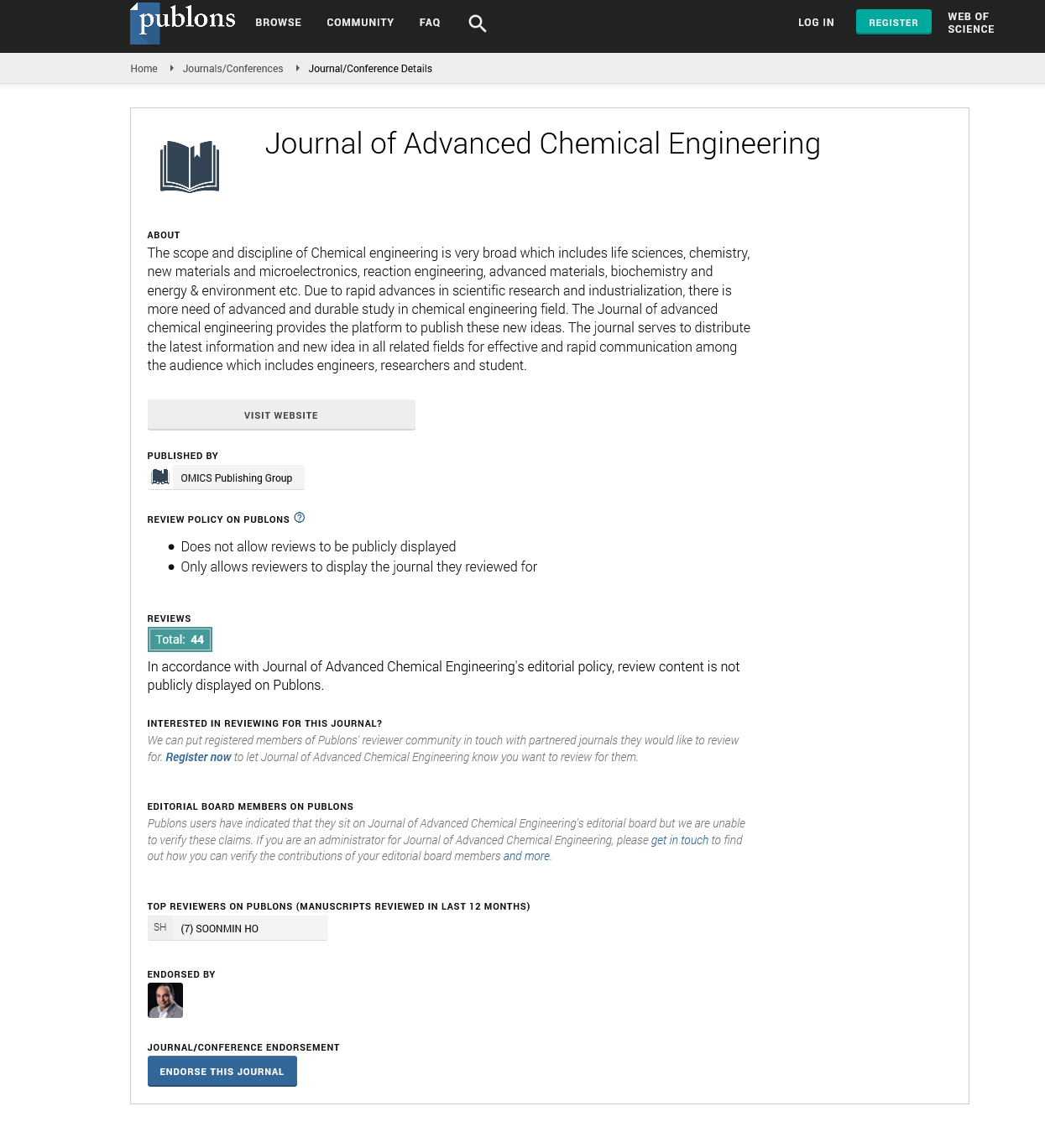Indexed In
- Open J Gate
- Genamics JournalSeek
- Smithers Rapra
- RefSeek
- Directory of Research Journal Indexing (DRJI)
- Hamdard University
- EBSCO A-Z
- OCLC- WorldCat
- Scholarsteer
- Publons
- Geneva Foundation for Medical Education and Research
- Google Scholar
Useful Links
Share This Page
Journal Flyer

Open Access Journals
- Agri and Aquaculture
- Biochemistry
- Bioinformatics & Systems Biology
- Business & Management
- Chemistry
- Clinical Sciences
- Engineering
- Food & Nutrition
- General Science
- Genetics & Molecular Biology
- Immunology & Microbiology
- Medical Sciences
- Neuroscience & Psychology
- Nursing & Health Care
- Pharmaceutical Sciences
Opinion Article - (2024) Volume 14, Issue 2
Role of Chemical Grafting Techniques in the Improvement of Hydrophobicity
Tom Streichert*Received: 20-May-2024, Manuscript No. ACE-24-26625; Editor assigned: 22-May-2024, Pre QC No. ACE-24-26625 (PQ); Reviewed: 03-Jun-2024, QC No. ACE-24-26625; Revised: 12-Jun-2024, Manuscript No. ACE-24-26625 (R); Published: 19-Jun-2024, DOI: 10.35248/2090-4568.24.14.339
Description
Vacuum Membrane Distillation (VMD) is an advanced separation technology widely used for desalination and purification processes. In VMD, a hydrophobic membrane is crucial for separating volatile components from a liquid mixture under vacuum conditions. Polyvinylidene Fluoride (PVDF) is a popular polymer used in membrane fabrication due to its inherent hydrophobic properties and chemical resistance. However, enhancing PVDF's performance in VMD applications can benefit significantly from chemical modification. Specifically, grafting hydrophobic functional groups onto the PVDF side chains can optimize membrane characteristics and improve separation efficiency.
Understanding PVDF and its role in membrane distillation
Polyvinylidene Fluoride (PVDF) is a fluoropolymer known for its excellent chemical resistance, mechanical strength, and thermal stability. These properties make PVDF a suitable choice for membrane applications in harsh environments. However, to further enhance its performance, particularly in VMD processes, modifications can be made to its side chains.
Properties of PVDF: PVDF exhibits strong hydrophobicity, which is beneficial for VMD, where hydrophobic membranes are required to repel water while allowing vapor to pass through. Its chemical stability ensures that PVDF membranes can withstand aggressive chemicals and high temperatures.
Limitations: Despite its advantageous properties, PVDF membranes may still benefit from further enhancement. Issues such as membrane fouling and lower flux rates can occur, which necessitates the modification of PVDF to optimize its performance.
Chemical grafting techniques for hydrophobic functional groups
Chemical grafting involves attaching functional groups to the side chains of PVDF to enhance its properties. In the context of VMD, introducing additional hydrophobic groups can further improve membrane performance by increasing resistance to fouling and enhancing separation efficiency.
Free radical grafting: This method involves generating free radicals to initiate the grafting process. Common techniques include UV irradiation or chemical initiators. Free radicals react with PVDF's side chains, enabling the attachment of hydrophobic functional groups.
Grafting from solution: In this approach, PVDF is dissolved in a suitable solvent, and the hydrophobic functional groups are introduced through a chemical reaction. This method allows for better control over the grafting process and the density of the functional groups.
Grafting onto surface: Surface grafting methods focus on modifying the outer layer of PVDF membranes. Techniques such as plasma treatment or chemical vapor deposition (CVD) can be employed to attach hydrophobic groups to the membrane surface.
Hydrophobic functional groups
Hydrophobic functional groups are chemical groups that do not interact favorably with water molecules. These groups tend to be nonpolar, lacking an affinity for water, and often found in organic molecules. Common examples include methyl (–CH3), ethyl (–CH2CH3), and phenyl (–C6H5) groups. Hydrophobic groups play an important role in biological systems, influencing the structure and behavior of molecules such as proteins and lipids. In proteins, hydrophobic amino acids often cluster together in the interior of the folded protein, stabilizing its three- dimensional structure. In cell membranes, hydrophobic lipid tails help form the lipid bilayer, creating a barrier that regulates the passage of substances into and out of cells.
Fluoroalkyl groups: These groups, such as Perfluorooctyl (PFO), are highly hydrophobic and can significantly enhance the water repellency of PVDF membranes. Their strong fluorine-carbon bonds provide superior resistance to wetting and fouling.
Long-chain alkyl groups: Introducing long-chain alkyl groups, such as octyl or dodecyl, can increase the hydrophobicity of PVDF. These groups improve the membrane’s resistance to water and organic solvents.
Silane coupling agents: Silane compounds, such as octyltri- chlorosilane or perfluorooctyltrichlorosilane, can be used to graft hydrophobic groups onto PVDF. These agents form stable covalent bonds with the polymer, enhancing its hydrophobic properties.
Advantages of hydrophobic grafting for VMD
There are number of advantages of VMD grafting mentioned as follows
Enhanced hydrophobicity: Grafting additional hydrophobic functional groups onto PVDF membranes increases their water repellency. This enhancement helps to prevent wetting and fouling, which are common issues in VMD processes. Improved hydrophobicity ensures that the membrane remains effective over extended periods.
Increased membrane flux: Membrane flux, or the rate at which vapor passes through the membrane, is a critical factor in VMD performance. By optimizing the hydrophobic properties of PVDF through grafting, the membrane can exhibit higher flux rates, leading to more efficient separation processes.
Reduced fouling: Fouling occurs when contaminants accumulate on the membrane surface, reducing its performance. Hydrophobic grafting helps to minimize fouling by repelling contaminants and maintaining a clean membrane surface. This leads to longer operational lifetimes and reduced maintenance requirements.
Applications in vacuum membrane distillation
Desalination: VMD is widely used for desalination processes to convert seawater or brackish water into fresh water. Hydrophobic PVDF membranes with grafted functional groups are particularly effective in desalination, as they ensure efficient separation of water vapor from dissolved salts and other contaminants.
Wastewater treatment: In wastewater treatment, VMD can be used to recover valuable resources from industrial and municipal wastewaters. Grafted PVDF membranes enhance the efficiency of contaminant removal and resource recovery by providing superior performance and resistance to fouling.
Chemical separation: VMD is also employed for separating volatile chemicals from liquid mixtures in the chemical industry. Hydrophobic PVDF membranes with optimized grafting can improve the separation efficiency of target chemicals, making the process more effective and economical.
Citation: Streichert T (2024) Role of Chemical Grafting Techniques in the improvement of Hydrophobicity. Adv Chem Eng. 14.339.
Copyright: © 2024 Streichert T. This is an open-access article distributed under the terms of the Creative Commons Attribution License, which permits unrestricted use, distribution, and reproduction in any medium, provided the original author and source are credited.

